Sulphides: Antimonite
 Diagnostic card.
Diagnostic card.
Antimonite - prismatic and acicular crystals
Sb 2 S 3
Diamond orthogonality
Hardness 2
Specific weight 4.6-4.7
Cleavage is perfect
Rough fracture
Color steel gray
Color in powder black-gray
Glitter metal

Antimonite, stibnit (antimony gloss). The gloss is metallic, opaque. Fracture stepped to uneven. It's fragile. Cleavage is perfect. It occurs mainly in low-temperature hydrothermal deposits. The crystals (rhombic system) are hexagonal, needle-shaped. Aggregates are usually radiant, less dense, granular. An important ore of antimony. Distribution: Germany, Yugoslavia, Algeria, Mexico, Bolivia, China, Japan, the CIS. Antimony ocher (stibiconite) occurs during the oxidation of antimony sulphides.
It has a steel-gray color, is opaque, with a bright metallic luster. Antimonite is represented by prismatic and acicular crystals, sometimes curved, with shading parallel to elongation. Often the crystals are grouped into fiber-fiber aggregates; Usually tangled-fibrous or dense masses. The mineral is soft, heavy, with perfect cleavage, parallel to elongation.
Diagnostic signs.
Crystals are flexible, but not elastic. Often covered with iridescent film, although in mass antimonite is sometimes converted to red kermesite or other powdered minerals (antimony ocher). This makes it possible to distinguish antimonite from bismuthin. Single scales can be melted in a candle flame, which is another difference from bismuthin, which does not melt.
Origin.
Antimonitis is a mineral of hydrothermal origin. It is associated with minerals of silver, lead, mercury; Can also be deposited from solutions of mineral sources.
Place of Birth.
Magnificent crystals, up to 50 cm in length, were found in the field (now worked out) of Ichinokawa (Japan). Other deposits, known for beautiful antimonite crystals - Felshebanya and Kapnik in Romania, many zones in the state of California (USA) and Borneo. Developed on an industrial scale deposits in the provinces of Hunan and Guangdong in China, where the antimonite occurs in conjunction with the cinnabar. Other deposits of industrial importance are found in Peru, Bolivia, Mexico and France. In Italy, beautiful crystals are mined in Tuscany, in Rosia (province of Siena) and Nicolette (province of Grosseto), as well as in Sardinia, where this mineral is represented as dense masses.
Application.
Antimonite is of great importance as a source of antimony. This element is used in various industries, including in alloys of metals, as well as in medicine.
In the translation, antimonite means "against monks." In one of the European monasteries, when fattening pigs, an antimonite powdered into powder was used, and the pigs were quite well fattened. For the best of reasons, the cook decided to add this powder to the dinner of his fellow monks, so that the monks were also well-fed and not thin. In the morning, all the monks died from poisoning, and the stone received its modern name.
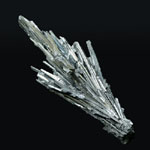
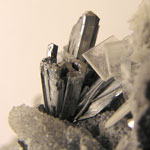
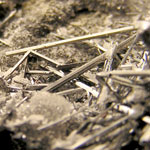

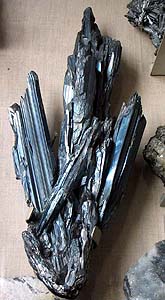
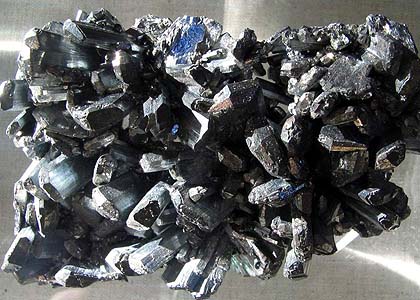
Antimonitis. Shikoku Island, Japan. Brush of pinacoid prismatic crystals. Baia-Spree, Romania. Photo: © А.А. Evseev.
ADR 6.1

Toxic substances (poison)
Risk of poisoning by inhalation, in contact with skin or if swallowed. Dangerous to aquatic environment or sewer system
Use a mask for emergency leaving the vehicle
White diamond, ADR number, black skull and crossbones
ADR 8

Corrosive (corrosive) substances
Risk of burns from skin corrosion. They can react violently with each other (components), with water and other substances. The substance that spilled / crumbled can emit a corrosive vapor.
Dangerous to aquatic environment or sewer system
White upper half of diamond, black - lower, equal, ADR number, test tubes, hands
| The name of a cargo that is particularly dangerous for transportation | room
UN |
Class
ADR |
| SB - POWDER | 2871 | 6.1. |
| Antimony Pentaphthyride Antimony Pentaphthoride | 1732 | 8 |
| Antimony Lactate | 1550 | 6.1. |
| Antimony Pentafluoride | 1732 | 8 |
| Antimony PENTACHLORIDE LIQUID | 1730 | 8 |
| Antimony PENTACHLORIDE SOLUTION | 1731 | 8 |
| SBAN COMPOUND INORGANIC LIQUID, NZK | 3141 | 6.1. |
| SBM INORGANIC COMPOUND, SOLID, NZK | 1549 | 6.1. |
| ANTIMONY TRICHLORIDE SOLID | 1733 | 8 |
| Antimony Potassium Tartrate | 1551 | 6.1. |
Poisonous and radioactive dangerous stones and minerals
** - poisonous stones and minerals (mandatory check in the chemical laboratory + explicit indication of toxicity)
** - radioactive stones and minerals (mandatory check on the standard dosimeter + ban on open sales in case of radioactivity exceeding 24 milli / g / h + additional measures of population protection)
Catalog of minerals and semi-precious stones of the world by groups
** - poisonous stones and minerals
** - radioactive stones and minerals


Comments
When commenting on, remember that the content and tone of your message can hurt the feelings of real people, show respect and tolerance to your interlocutors even if you do not share their opinion, your behavior in the conditions of freedom of expression and anonymity provided by the Internet, changes Not only virtual, but also the real world. All comments are hidden from the index, spam is controlled.